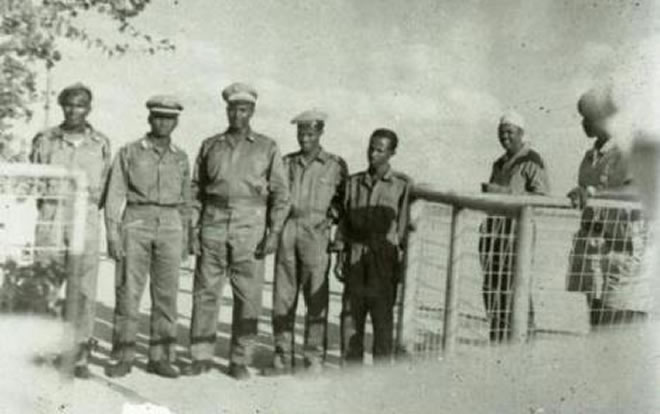by Mohamed I. Trunji
Thursday, December 26, 2019

Members of 1961 Aborted Military Coup - PHOTO| somalilandstandard.com
The long sought, but unplanned and hastily executed union of the two former colonial territories, North and South, in 1960, raised almost insurmountable problems of political, legal, linguistic, administrative and economic integration to give practical effect to the union. Amid this feeling of general uneasiness of the people, twelve young army lieutenants, trained in Britain, were aggrieved that the British officers, who had left the Northern battalion, were replaced by Somalis of field rank from the south, who had had paramilitary training in Italy. Feeling was widespread among northerners that the major advantages of union lay with the south. The young officers thus planned and carried out a bloodless coup d’état in December 1961, to overthrow the government in the north but they failed to win the support of the soldiers and the coup collapsed within a day. Later, the officers were charged, before ordinary Court, with waging war against the state, punishable by death under Section 121 of the Indian Penal Code. In strict adherence to the spirit of the constitution and respect for the rule of law, the then President of the Republic, Aden Abdulla, rejected calls for a military tribunal to be established for the trial of the rebellious officers “to ensure long and deterrent punishment rather than bringing it before an ordinary court”, as suggested by the Commander of the National Army (Diary January 6, 1962)
A farcical Trial
Since the offence has been committed in the North, the Regional Court of Hargeisa had jurisdiction in the case. For security reason, however, the Supreme Court directed the Hargeisa Court to hold the trial in the capital city of Mogadiscio. The Court comprised an English Judge and two Somali Assessors. Although the Hargeisa Court was physically located in Mogadiscio, the trial was governed by the Northern law which, at the time, was the Indian Penal and the Indian Code of Criminal Procedure. (The integrated Somali Penal Code and Criminal Procedure had not yet been enacted when the trial took place)
The Prosecutor was an Italian Judge, Severino Santiapichi, unfamiliar with Indian Law and with English language. Judge Sasntipichi had served as a Judge in Somalia since the Trusteeship time. He lectured in Criminal Procedure Law at the University of Mogadiscio and was the author of a book on Diyah, or blood money, in Somali traditional law. In Rome, he presided over the trial of the Red Brigades, a far-left terrorist organization and guerilla based in Italy, accused of kidnapping and murdering the former Italian Prime Minister, Aldo Moro in 1978.
The presiding Judge was a Briton, unfamiliar with Somali legal system, and with no knowledge of Italian or Somali languages. The accused were allowed to hire foreign lawyers conversant with English laws; they hired two Indian attorneys practicing in Kenya. As the funds collected by their immediate relatives proved insufficient to fully cover the Lawyer’s fees, amounting to ShSo 41,000, the government settled the balance, amounting to ShSo 29,060 as provided by article 41 of 1960 Constitution.
Two legal traditions unable or unwilling to understand each other
During the trial (January-March1963) eighty-four prosecutor witnesses were heard. They testified in Somali, which was translated first by a Somali interpreter in Italian for the benefit of the prosecutor and then by an American interpreter into English for he benefit of the Judge and the defence attorneys. (P. Contini 1969).
The written depositions taken during the 14-months long investigations and the testimony of the witnesses at the trial brought about in great detail the events of 9 and 10 December 1961 and the role of the accused. On the basis of the clear evidence produced, the Prosecutor requested the accused be sentenced.
However the Judge threw out the case stating that “in no case has the Prosecutor made the prima facie case requiring any accused to make his defence” As a result, all the twenty-one were acquitted on a flimsy technicality based on the argument that they had not been identified not even had their proper names and military ranks clearly mentioned.
For the Prosecutor enough evidence had been produced to the Court to warrant the conviction of the defendants, but the Court held that the prime facie case had not been made. Consequently, the defendants were acquitted on the ground that ‘the witnesses did not point them out’. The prosecutor was convinced that the witnesses who appeared before the Court had known all the defendants for a long time; had worked with them and were therefore, in a position to know them by name and military rank. What doubt, then, could arise as to their identification?.
The prosecutor argued that the formal procedure for the identification of a person should be applied where a question on the identity of such person arises. He went on to say: ‘the least we can say is that the reasons on which the Judge based the decision are childish’. As Paolo Contini eloquently put it ‘this trial was probably the clearest case of two legal traditions being unable or unwilling to understand each other’. (P. Contini 1969)
The Somali government quickly reacted to the embarrassing Court ruling, by ordering the British Judge to leave the country within twelve-hours. The Prosecutor filed an appeal against the Court ruling. The date for the hearing of the appeal has been postponed several times until, early in 1965, all the defendant benefitted from an amnesty, and the appeal was dropped (P. Contini 1969)
M. Trunji
E-mail: [email protected]